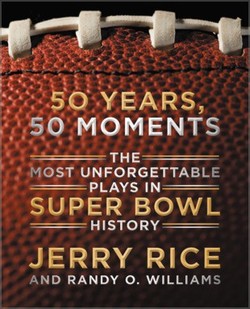
Written by Hall of Fame wide receiver Jerry Rice and sportswriter/author Randy O. Williams, the book counts down the 50 most memorable plays in Super Bowl history. Packed with vivid color photographs and a lively narrative, “50 Years, 50 Moments” is gold mine for NFL history junkies.
Rice is one of those junkies.
“I’m a student of the game and feel that players back in the day made the sport what it is today,” he writes.
Rice and Williams interviewed players, coaches, executives and broadcasters and compiled a list of 50 signature moments or performances. All the good ones are included.
There are key interceptions, like Malcolm Butler’s game-saving pick in Super Bowl XLIX, James Harrison’s 100-yard theft and return for a score in Super Bowl XLIII at Tampa’s Raymond James Stadium and Jack Squirek’s big play before halftime that turned Super Bowl XVIII (also in Tampa) into a rout.
Great runs are included, like John Riggins’ fourth-down burst for a touchdown in Super Bowl XVII and Marcus Allen’s 74-yard TD run the following season. Oh yeah, and William “The Refrigerator” Perry’s 1-yard touchdown run in Super Bowl XX.
The catches of Lynn Swann, John Stallworth and David Tyree are covered, along with the passing of Joe Montana, Phil Simms, Doug Williams — and Garo Yepremian.
Special teams thrills come alive again, like the Saints’ surprise onside kick to open the second half of Super Bowl XLIV, or Desmond Howard’s record-setting 99-yard kickoff return for a touchdown in Super Bowl XXXI. Readers can relive the jubilation of Jim O’Brien, whose field goal won Super Bowl V for the Baltimore Colts.
Even the heartbreaking, frustrating moments are included, like a wide-open Jackie Smith dropping a pass in the end zone, or Scott Norwood’s wide-right field goal attempt that denied Buffalo a victory against the Giants in Super Bowl XXV. Or a wide-open Jimmy Orr, waving his hands futilely near the goal line during Super Bowl III, signaling he was open to Earl Morrall. The Colts’ quarterback did not see Orr and threw instead toward Jerry Hill, but his pass was intercepted by Jim Hudson and the Jets held on to a 7-0 lead at the half.
Team efforts are praised, like the Miami Dolphins’ near-perfect game (except for the Yepremian gaffe) in Super Bowl VII, which completed a perfect season; and the 49ers’ goal-line stand against Cincinnati in Super Bowl XVI.
What makes this book enjoyable is the authors’ attention to detail. My favorite memory from this book is called “The Swat.” In Super Bowl XVII, Joe Theismann’s alert play prevented Miami’s Kim Bokamper from intercepting a batted ball and running for a touchdown. With Miami holding a 17-13 lead at the time, a touchdown would have made a Redskins comeback difficult.
The only thing missing is the Leon Lett fumble, but that was more comical than memorable.
Each chapter has a complete boxscore with starting lineups and game statistics.
“I learned more than I ever thought I would about the game I love,” Rice said.
He’s right. Even hardcore football history buffs are certain to learn a thing or two.
So what was the authors’ choice as the greatest moment in Super Bowl history? I am not going to play spoiler, but you probably won’t be surprised — I guarantee it.
 RSS Feed
RSS Feed
